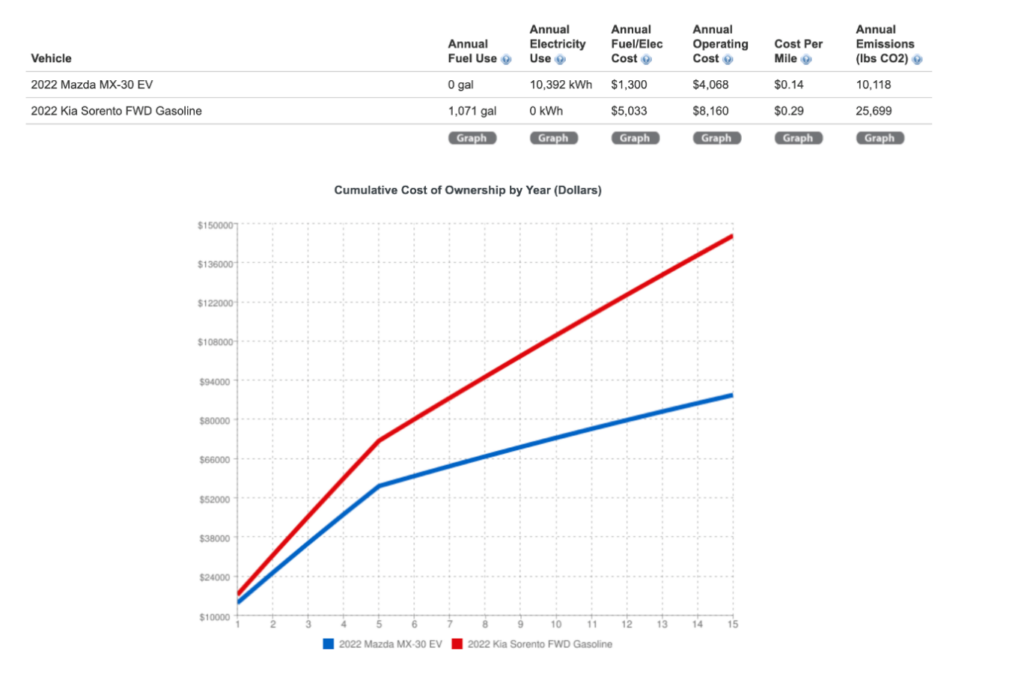
By Caroline Draughon and Jaclyn Lea, Policy Interns
With rising gas prices as a result of our exposure to a volatile, cartel-controlled commodity, national security concerns over oil and gasoline, and growing government focus on incentivizing electric vehicle (EV) adoption, EVs have become increasingly appealing to consumers in the U.S. EVs provide a number of benefits to the environment, economy, and public health. According to the U.S. Department of Energy, EV sales grew by 85 percent from 2020 to 2021, and are projected to increase over the next few years. However, EVs account for less than 3 percent of overall new vehicle sales in the U.S.
Americans are clearly curious about EVs. So why aren’t more people buying them? According to consumers, the main reason is that EVs tend to have a higher sticker price compared to traditional internal combustion engine vehicles (ICEVs). These higher sticker prices are mostly due to the high cost of EV batteries and ongoing supply chain problems. The materials and manufacturing chains used to make EV batteries have not yet reached economies of scale to be competitive across all vehicle models. Consumers are in luck, though, as battery prices have dropped significantly by 89% over the last decade and are expected to continue to decline and bring EV prices to parity with ICE.
While EVs are more expensive up front, they tend to be much cheaper than ICEVs over the lifetime of the vehicle. If you take into consideration the different factors, such as maintenance and gas prices versus electricity, ICEV owners end up spending more on transportation. In fact, EV owners often recoup the initial costs and see savings within the first few years. EVs require significantly less maintenance, whereas ICEVs require services like oil changes, engine fluid checks, and more.
Geopolitics can also drive up the cost to fill our gas tanks; In the last year, with Russia’s invasion of Ukraine and market manipulation by OPEC+, consumers saw up to $6 per gallon at the pump, making the switch to EVs a desirable alternative with cheaper and more stable energy prices. EVs save money on fuel costs even when gas is at a regular price. As shown in the figure below, the national average gas price is nearly three times higher than the national average electricity price. . EV owners can save even more money by taking advantage of time of use (TOU) rates and charging at off-peak hours when electricity is cheapest.

Source: Alternative Fuel Data Center
There are numerous consumer-based tools available to compare the cost of EVs to similar ICEVs, such as the Alternative Fuels Center Vehicle Cost Calculator. The tool works to give potential buyers visibility into the total cost of ownership (TCO) of an EV, which includes the purchase costs but also the energy and maintenance costs over the lifetime of the vehicle based on inputs that can be customized to the consumer’s real-life driving patterns. For fleets, the Electrification Coalition also has developed the Dashboard for Rapid Vehicle Electrification (DRVE) Tool, which enables fleet managers to quickly compare their existing fleets for which vehicles can be electrified for the greatest savings.
Saving Money with an EV in Georgia
Consumers can save money with an EV – here’s how. As a Georgia-based consumer interested in buying a new car, I wanted to compare prices between an EV and its ICEV equivalent. I used Kelly Blue Book’s car comparison tool to compare prices between the 2022 Mazda MX-30 and a comparable gas-powered model, as suggested by the tool, the 2022 Kia Sorento. As shown in the figure below, the EV is priced at an affordable rate, just $1,000 more than its gas-powered competitor, before factoring in any incentives.

How does an EV fit your lifestyle?
Figuring out which EV is best for you means determining what type of driver you are. This varies between those who are daily commuters or long-distance drivers. Balancing range and cost are often the top consideration when buying an EV, and while many cite range anxiety as a top barrier to adoption, the charging infrastructure available across the country has continued to grow substantially every year. Thanks to the National Electric Vehicle Infrastructure program under the Bipartisan Infrastructure Law, $5 billion will be allocated to accelerating the build-out of our national EV charging network. However, if you’re thinking about making an EV your daily driver, it’s a good idea to track how many miles you drive in an average day to consider what range you might need in your EV. As a college student, my driving style revolves around daily short drives around campus. I estimate I drive about 30 miles a day. I used that to decide which vehicle best met my needs for how far I expect to drive and the access to charging I anticipate. The Mazda MX-30 fits both my budget and my driving style, as it is purposed for trips under 100 miles.
EV Incentives that are Available to You
After I identified the EV that fit my needs, my next step was to see if there were any incentives available from the federal or state government, or local utilities, to see if I could receive assistance in bringing the purchase cost down. Incentives vary from state to state and can even differ between municipalities and counties. The PlugStar incentive tool, presented by Plug In America, can help consumers narrow down which of these incentives can aid them in purchasing an EV based on their county.
EV incentives go past initial purchasing prices. In Georgia, incentives are also provided by utilities, such as Georgia Power, which can help reduce the other costs associated with owning an EV, like charging. Georgia Power offers an Electric Vehicle Time-of-Use Rate incentive, a TOU rate for residential customers who own an EV. This rate offers lower prices from 11 p.m.–7 a.m. to encourage nighttime EV charging. In addition, Georgia Power also offers residential customers a $250 rebate for Level 2 EV charger installment.
After my research, I found the only incentive I would qualify for as a Georgia consumer was the federal tax credit of $7,500. This brought my initial purchasing price of the Mazda MX-30 down to about $27,000. Charging my EV at home would cost about $0.12 per kilowatt-hour or $0.79 per hour of charging. Typically, a home charger installation would cost about $1,200. However, the Georgia Power home charger rebate offers an instant rebate of $250 for Level 2 chargers. Because I am a college student who lives in a rental home, I found that home charging installation was not congruent with my living situation. Instead, I decided that the public Level 2 chargers on campus provided the perfect opportunity for me to charge my vehicle during the time I spend in class and on campus. The public chargers in my area cost on average $0.75/hr. It takes about 5 hours to fully charge the Mazda MX-30, roughly the same amount of time I spend on campus during the day, bringing the cost to fully charge my vehicle to at most $3.75 – a conservative estimate considering I don’t expect to be charging from zero to full every day. In comparison, the average cost of gas in my area is nearly $3 per gallon. Using the Alternative Fuels Center vehicle cost calculator to compare the Mazda MX-30 and its ICEV competitor the Kia Sorento, I found that the Mazda EV would cost me significantly less in fueling, operating, and maintenance costs. In addition, by purchasing this EV I would be contributing about 61% less in greenhouse gas emissions than its ICEV competitor per year.

Source: Alternative Fuels Center vehicle cost calculator
The incentives I qualified for are only a part of upcoming Georgia policies and opportunities that will benefit EV adoption. Georgia is increasingly evolving investments into EV manufacturing and infrastructure. In December 2021, Rivian pledged to build a 2000-acre $5 billion manufacturing plant outside of Atlanta that will eventually create 7,500 jobs. Once online, the Georgia facility will be capable of producing up to 400,000 electric pickups and SUVs annually. In September of 2022, the Georgia Department of Transportation’s National Electric Vehicle Infrastructure plan was approved. Funded by the Bipartisan Infrastructure Law to deploy a nationwide electric vehicle (EV) charging network, the Georgia Electric Vehicle Infrastructure Deployment Plan will guide the administration of $27 million of federal funds allocated to Georgia to build EV charging infrastructure along its alternative fuel corridors and accelerate Georgia’s electric mobility future. As Georgia moves forward towards electric mobility, I feel confident that investing in an electric vehicle will be a much cleaner and cheaper option for both myself and other consumers in the market for a new car.
